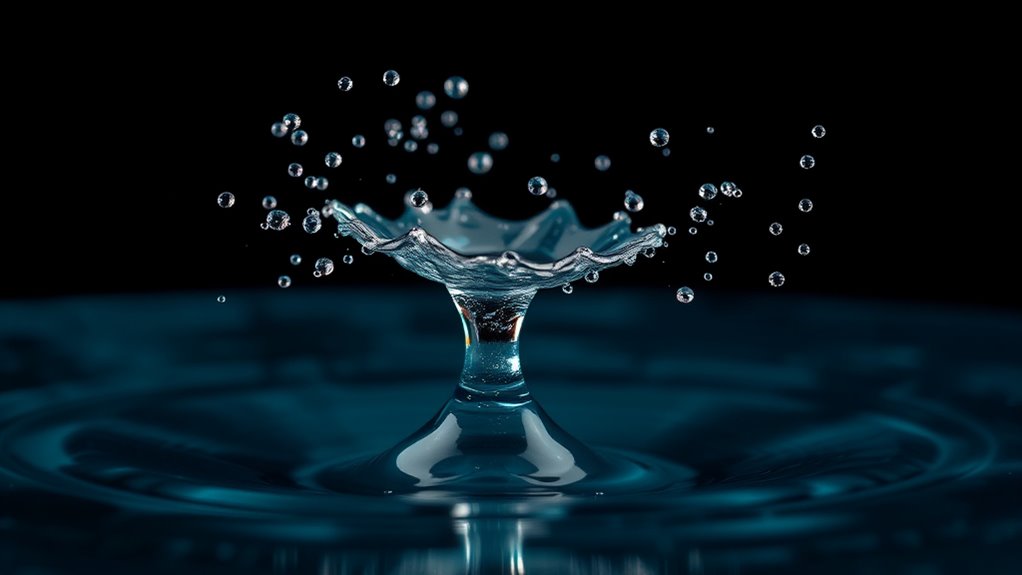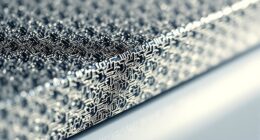If you’re looking for the top high-speed cameras in 2025, I recommend checking out options like USB3.0 industrial cameras with 790FPS, high-res microscopes, and versatile 4K or 8K content cameras. These models offer high frame rates, excellent image quality, and easy connectivity for experiments or content creation. If you’re curious about which fits your needs best, continue exploring, and you’ll discover more about the advanced features that can elevate your work.
Key Takeaways
- The latest high-speed cameras offer ultra-fast frame rates and high-resolution imaging suitable for detailed experimental analysis.
- Compatibility with various software and connectivity options ensures seamless integration into research workflows.
- Compact, lightweight designs enhance portability for field experiments and on-the-go data capture.
- Advanced features like global shutters, high sensor sensitivity, and precise triggering improve image clarity and timing accuracy.
- Multi-platform support, including Windows, Linux, and macOS, facilitates versatile usage in diverse experimental environments.
High Speed USB3.0 Industrial Camera (640×480, 790FPS)
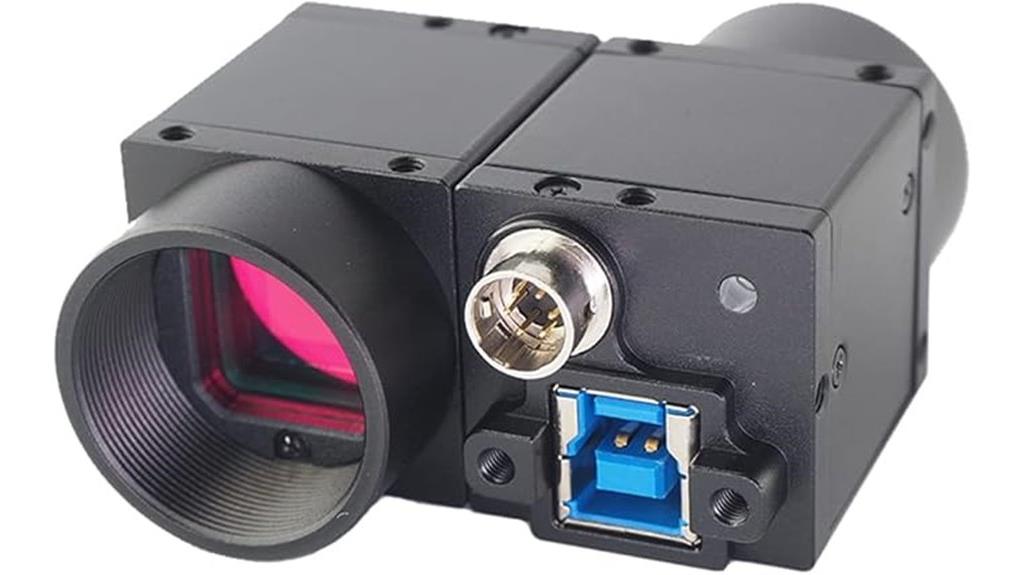
If you’re looking for a high-speed camera that delivers impressive frame rates at an affordable price, the High Speed USB3.0 Industrial Camera (640×480, 790FPS) is an excellent choice. I’ve found it perfect for capturing fast movements in industrial and machine vision applications. Its global shutter ensures sharp images without distortion, and support for Windows and Linux SDKs makes integration straightforward. It’s compact, lightweight, and supports external triggers and flash control for precise timing. While lighting conditions greatly affect performance, with bright illumination, I’ve achieved remarkable frame rates and decent image quality, making it a versatile tool for high-speed experiments.
Best For: professionals and researchers in industrial automation and machine vision seeking high-speed, high-resolution imaging with flexible integration options.
Pros:
- Achieves high frame rates up to 790 fps at 640×480 resolution, ideal for capturing fast movements.
- Supports both Windows and Linux SDKs, facilitating easy integration into various systems.
- Compact and lightweight design with external trigger and flash support for precise control.
Cons:
- Requires intense lighting to reach optimal frame rates and image brightness, which can increase setup complexity.
- Color images often appear dark and grainy at high speeds, especially without proper lighting.
- Linux setup can be challenging, with no Android app available and the need for manual driver compilation.
CMEX-18 Pro High-Speed Microscope Camera
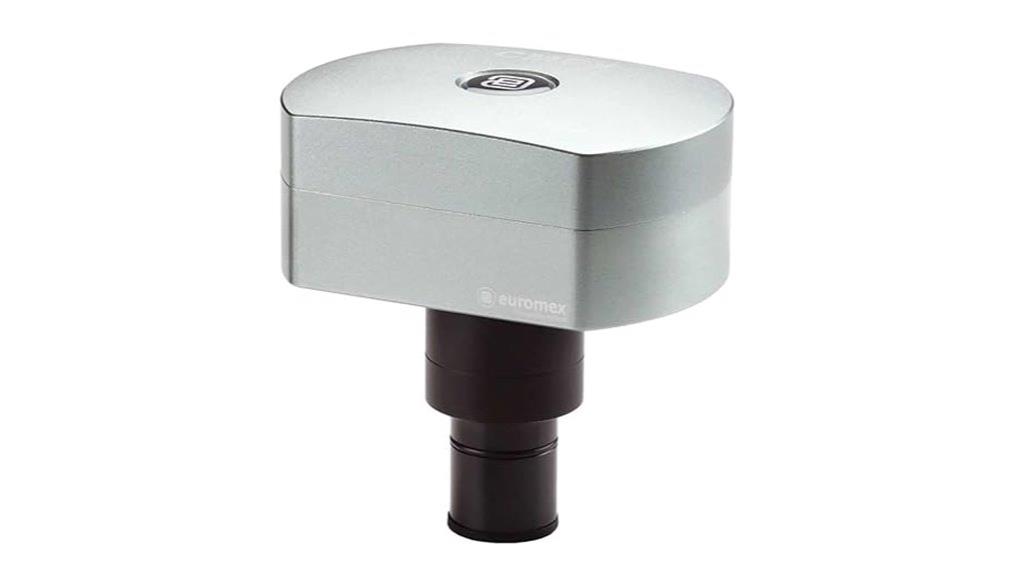
Looking for a high-speed microscope camera that delivers exceptional image quality and rapid data capture? The CMEX-18 Pro is perfect, equipped with an 18MP CMOS sensor that supports 12-bit grayscale and 24-bit color. Its high-speed USB 3.0 interface ensures fast frame rates, ideal for live imaging and detailed analysis. With excellent color reproduction and a low noise ratio, it captures clear, accurate images. The camera integrates seamlessly with the ImageFocus Alpha software, enabling measurements, annotations, and video recording. Designed for lab, educational, and industrial use, the CMEX-18 Pro offers versatile compatibility with various microscopes and systems.
Best For: researchers and professionals requiring high-speed, high-resolution imaging for life science, material science, or industrial microscopy applications.
Pros:
- 18MP CMOS sensor delivers ultra-high-resolution images with excellent detail.
- High-speed USB 3.0 interface allows for rapid frame rates suitable for live imaging.
- Seamless integration with ImageFocus Alpha software enables comprehensive analysis, measurements, and annotations.
Cons:
- Requires a minimum of 2GB RAM and a 17-inch display, which may limit use with older systems.
- Potentially higher cost compared to lower-resolution or entry-level cameras.
- Compatibility is limited to Windows 10 and 11, possibly excluding users on other operating systems.
Variable Focus Webcam with 2MP HD 1080P and Optical Zoom
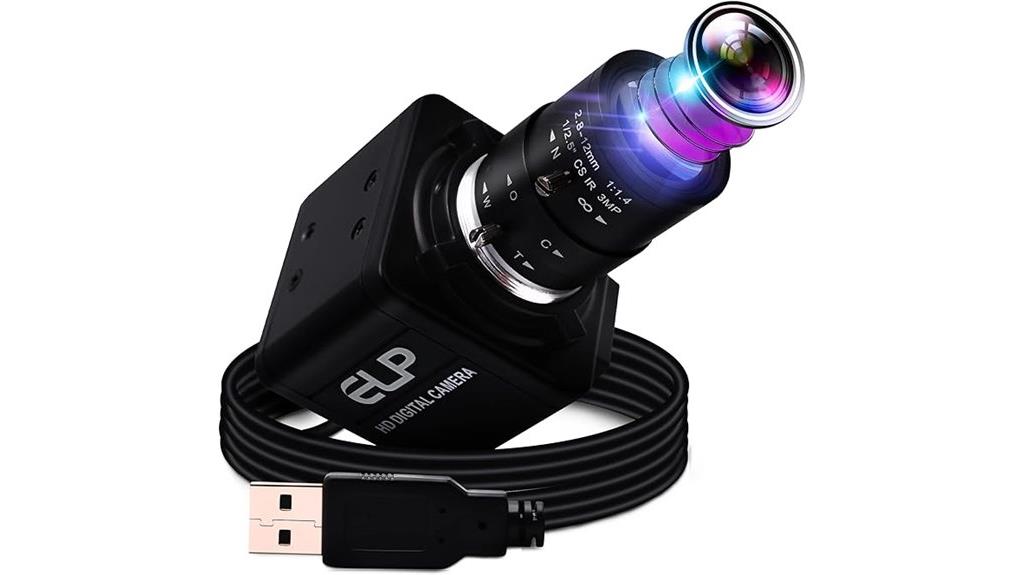
The Variable Focus Webcam with 2MP HD 1080P and Optical Zoom stands out as an excellent choice for professionals and hobbyists who need precise control over their close-up imaging. Its sturdy all-metal design ensures stability during use, whether for industrial, medical, or creative projects. With 2MP resolution at 60fps and 10X optical zoom, it captures sharp, detailed images. Manual focus and zoom rings allow fine adjustments, though sensitivity can be high. Compatibility spans across multiple platforms, supporting popular streaming and conferencing software. Ideal for high-speed close-ups, it performs well in various lighting conditions, especially when complemented with proper external lighting.
Best For: professionals and hobbyists who require precise, detailed close-up imaging for industrial, medical, or creative projects with reliable stability and high-quality zoom.
Pros:
- Durable all-metal housing provides stability and long-term reliability.
- 10X optical zoom and manual focus rings allow fine-tuned adjustments for detailed close-ups.
- Wide compatibility with multiple platforms and streaming/conferencing software for versatile use.
Cons:
- Sensitive focus rings may require tools for precise adjustments.
- Lack of built-in mounting hardware may necessitate external tripods or mounts.
- Image quality can diminish in low-light conditions without additional lighting or software adjustments.
4K Digital Camera for Photography and Vlogging (Point & Shoot, 50MP, 16X Zoom, 32GB SD)

For casual photographers and vloggers seeking a portable, easy-to-use device, the K Digital Camera stands out with its impressive 50MP resolution and 16X zoom, making it perfect for capturing sharp images and vibrant videos on the go. Its 4K UHD video recording and flip screen simplify selfie and vlogging shots, while its lightweight design fits easily into pockets. The camera’s quick autofocus and accurate colors ensure crisp photos and smooth videos in good lighting. With accessories like a 32GB SD card and carrying pouch, it offers excellent value for beginners, travelers, or social media creators who want professional-like results without complexity or bulk.
Best For: casual photographers, vloggers, and social media content creators seeking a portable, easy-to-use camera with professional-like quality.
Pros:
- High 50MP resolution and 4K UHD video for sharp, vibrant images and videos
- Lightweight, compact design with a flip screen ideal for selfies and vlogging
- Comes with useful accessories like a 32GB SD card, carrying pouch, and lanyard for immediate use
Cons:
- Battery life of around 60 minutes per full charge may require extra batteries for extended shoots
- Limited advanced features for professional photographers or videographers
- Autofocus performance may decline in low-light conditions
5K Digital Camera with 64MP Dual-Lens for Content Creators
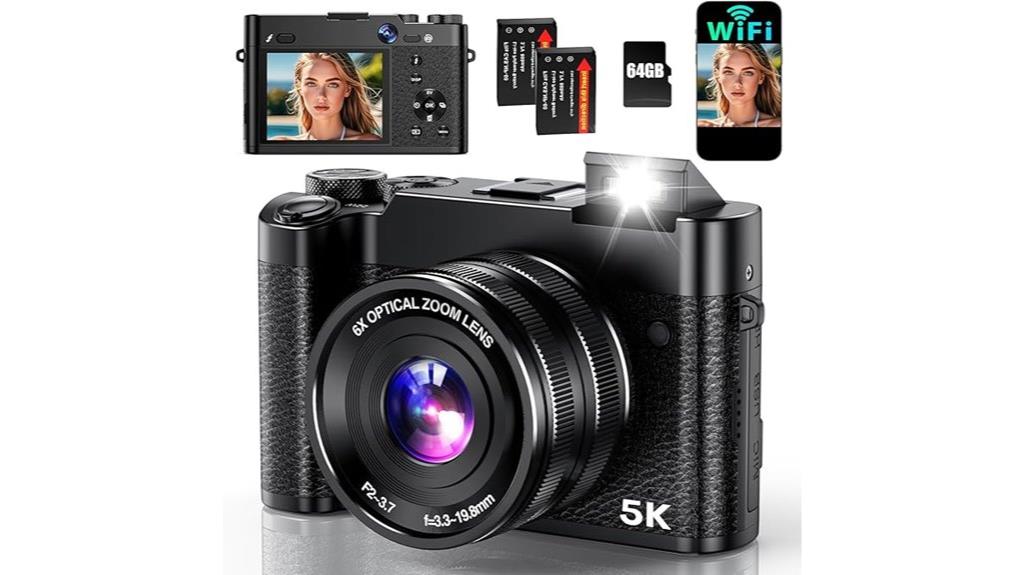
Content creators seeking a portable yet powerful camera will appreciate the K Digital Camera with 64MP dual-lens system, which combines high-resolution imaging with versatile filming capabilities. Its 5K 64MP sensor and IMX386 chip deliver stunning, detailed photos and ultra-sharp 5K videos. The 6X optical zoom, quick autofocus, and anti-shake ensure clear shots even from a distance or in low light. Its lightweight, compact design with a flip screen makes it perfect for vlogging and on-the-go shoots. Built-in WiFi, live streaming support, and included accessories offer seamless sharing and extended shooting. Overall, it’s a user-friendly, feature-rich choice for content creators wanting professional results in a portable package.
Best For: content creators, vloggers, and travelers seeking a portable, high-quality camera with advanced features for photography and videography.
Pros:
- Superior 64MP resolution and 5K Ultra HD video deliver crisp, vibrant images and sharp videos.
- Compact, lightweight design with flip screen and intuitive controls ideal for on-the-go shooting and beginners.
- Built-in WiFi and accessories enable seamless sharing, live streaming, and extended shooting sessions.
Cons:
- Not a professional DSLR, so it may lack some advanced manual controls preferred by professional photographers.
- Limited zoom range compared to larger, more specialized cameras; best suited for casual and moderate zoom needs.
- Battery life, while robust, may require extra batteries for extended shoots, especially during continuous streaming or filming.
8K Digital Camera with 88MP, WiFi & Touch Screen, 16X Zoom for Vlogging and Photography
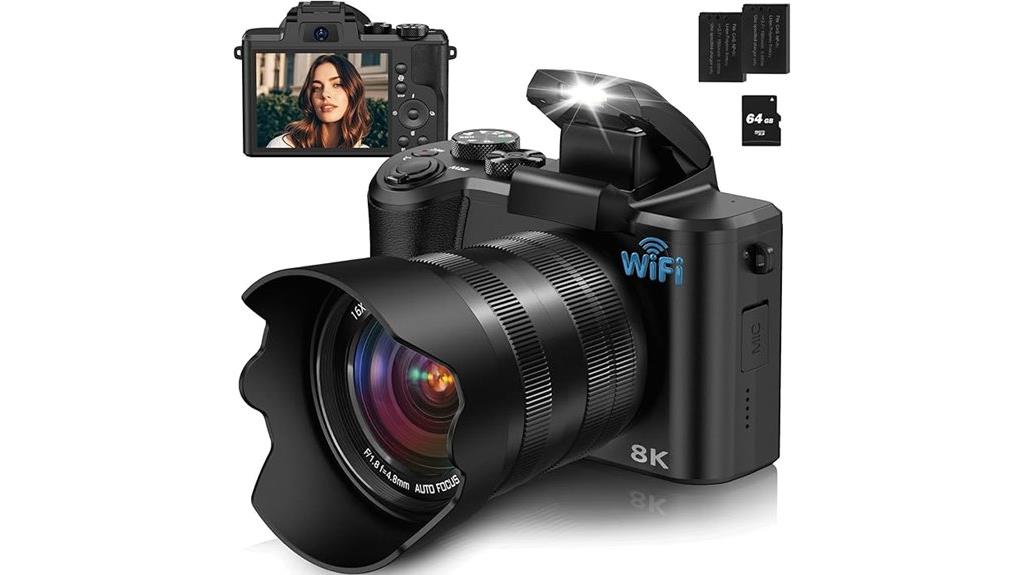
If you’re looking for a compact, user-friendly camera that delivers stunning 8K images and versatile shooting options, the K Digital Camera with 88MP, WiFi, and Touch Screen is an excellent choice for vloggers and photography enthusiasts. Its advanced IMX586 sensor captures sharp, detailed 8K photos and videos, while 16x optical zoom ensures clarity even at a distance. The dual-lens design supports selfies and varied shots, and built-in stabilization prevents blur. Portable and lightweight, it comes with essential accessories, making it perfect for travel. Plus, Wi-Fi and HDMI enable instant sharing and live streaming, elevating your content creation effortlessly.
Best For: content creators, travel enthusiasts, and beginners seeking a portable, high-resolution camera with versatile shooting capabilities.
Pros:
- Delivers stunning 8K ultra HD images and videos with detailed clarity.
- Compact, lightweight design ideal for travel and daily use.
- Features Wi-Fi and HDMI for instant sharing, live streaming, and easy content management.
Cons:
- Some users mention the build feels cheap or fragile.
- Display may not be true HD according to some reviews.
- Missing accessories like cords or extra batteries upon arrival in certain cases.
FLATIC 5K Digital Camera with WiFi and 64MP Cameras
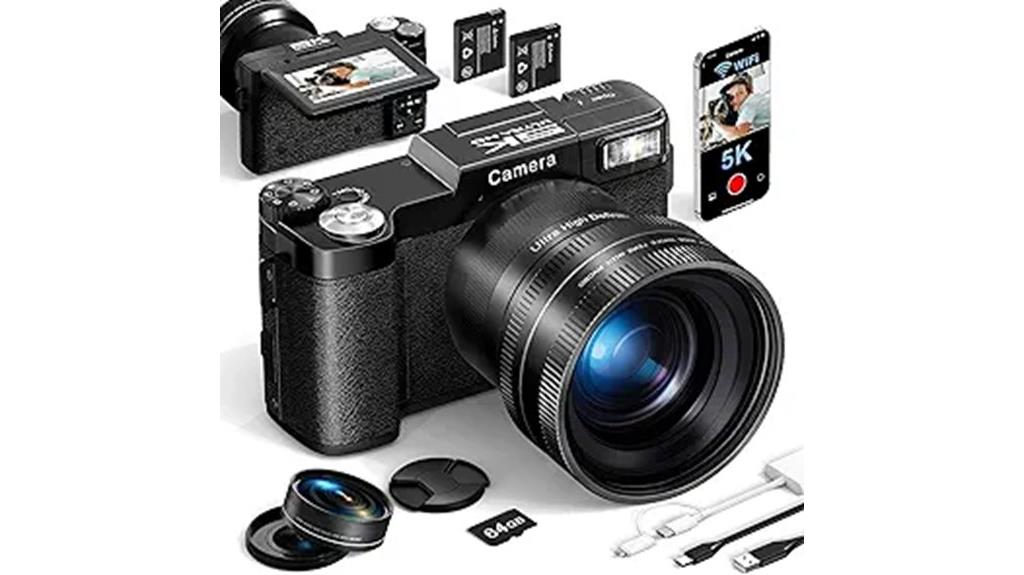
The FLATIC 5K Digital Camera with WiFi and 64MP sensors stands out as an excellent choice for casual photographers and content creators seeking high-quality imagery without the complexity of professional-grade gear. It captures stunning 64MP photos and ultra-clear 5K videos, with features like autofocus, 18x digital zoom, and stabilization ensuring sharp results. Its versatile lenses include macro and wide-angle options, while the 180° flip screen makes selfies and vlogging easy. WiFi connectivity allows quick sharing, and the compact design makes it perfect for travel and casual shooting. With dual batteries and a user-friendly interface, it’s an accessible, all-in-one tool for capturing moments in vibrant detail.
Best For: casual photographers, vloggers, and social media content creators seeking an easy-to-use, portable camera with high-resolution photos and videos.
Pros:
- Captures crisp 64MP photos and smooth 5K videos suitable for vlogging and social media.
- Features a flip screen, macro and wide-angle lenses, and user-friendly controls ideal for beginners.
- Supports WiFi transfer, includes dual batteries, and comes with a comprehensive starter kit for easy sharing and extended use.
Cons:
- Performs best in good lighting conditions; limited for professional photography.
- Some users report discrepancies in resolution claims, such as false 6K resolution.
- Not suitable for high-end professional applications or demanding photography needs.
AmScope 4K Microscope Camera (AF408)
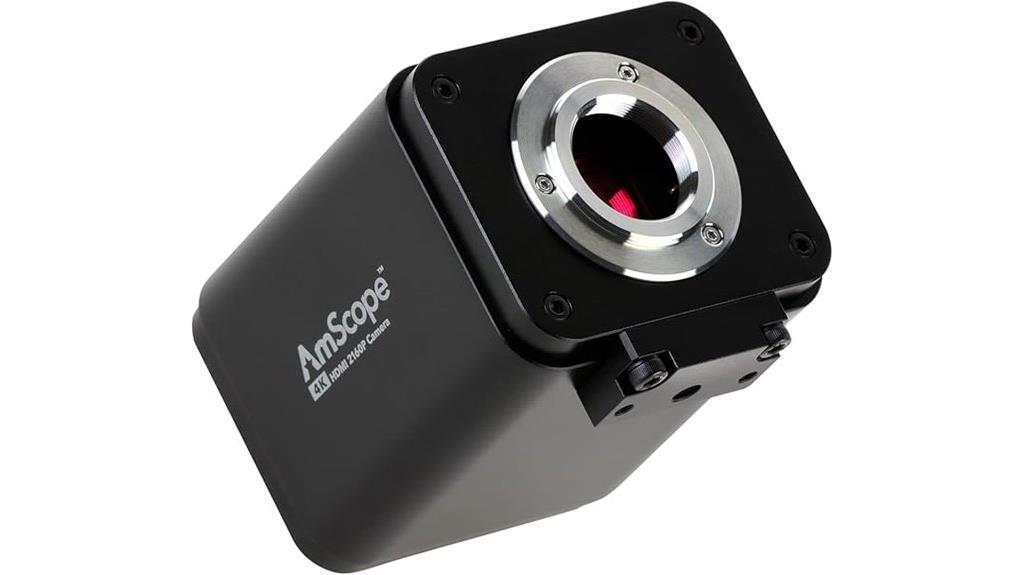
For professionals who need crystal-clear, high-resolution imaging during microscopic experiments, the AmScope 4K Microscope Camera (AF408) stands out with its 4K Ultra HD video and photo capabilities. It delivers four times the detail of 1080p, with automatic focus for precise imaging of PCBs, topological features, and intricate specimens. Supporting HDMI output at 60fps ensures smooth live viewing, while USB and Wi-Fi connectivity offer flexible control and image capture options. The built-in software enables measurement, stitching, and focus stacking, making it ideal for quality control and research. Its compact design and included accessories allow standalone operation or integration with PCs for versatile microscopy workflows.
Best For: professionals and researchers needing high-resolution, real-time imaging and detailed analysis for microscopy, quality control, or research applications.
Pros:
- Provides stunning 4K Ultra HD resolution for sharp, detailed images and videos
- Supports automatic focus and HDMI output at 60fps for smooth live viewing
- Flexible connectivity options via USB and Wi-Fi for standalone use and remote control
Cons:
- Slightly larger and heavier compared to basic digital microscopes, which may impact portability
- Requires compatible microscopes with C-mount or additional adapters for optimal performance
- Advanced features may have a learning curve for new users unfamiliar with microscopy software
AmScope 3.0 MP USB Microscope Camera
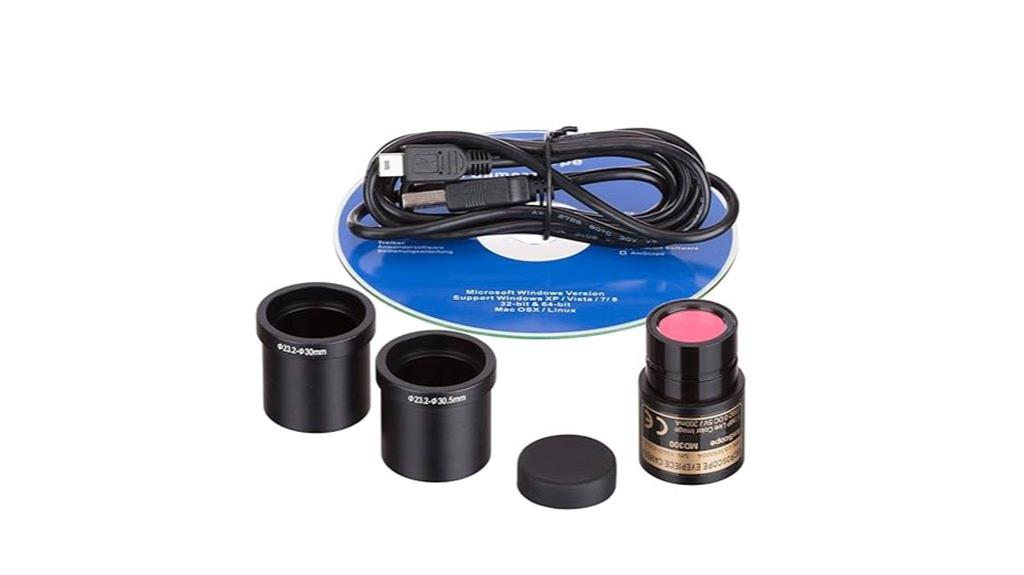
Designed with versatility in mind, the AmScope 3.0 MP USB Microscope Camera is ideal for both professionals and educators seeking high-quality imaging. It captures sharp still images and streams smooth live videos with its 3MP resolution. Compatible across various operating systems like Windows, Mac, and Linux, it integrates easily with popular software for editing, stitching, measurement, and video recording. The camera fits three mounting sizes, making it adaptable to different microscopes, and includes adapters for quick setup. Plus, its child-friendly software makes it accessible for younger users, making it a flexible choice for a wide range of applications.
Best For: educators, students, and professionals seeking an versatile, high-quality microscope camera that is easy to operate and compatible across multiple operating systems.
Pros:
- High-resolution 3MP image and video quality for detailed captures and streaming
- Wide compatibility with Windows, Mac OS X, and Linux, plus adaptable mounting options
- Child-friendly software included for easy, fun operation suitable for younger users
Cons:
- May require additional adapters for certain microscope mounts, adding to setup time
- Advanced software features might have a learning curve for new users
- Limited to 3MP resolution, which may not suffice for extremely high-detail imaging needs
8K Digital Camera for Photography and Vlogging
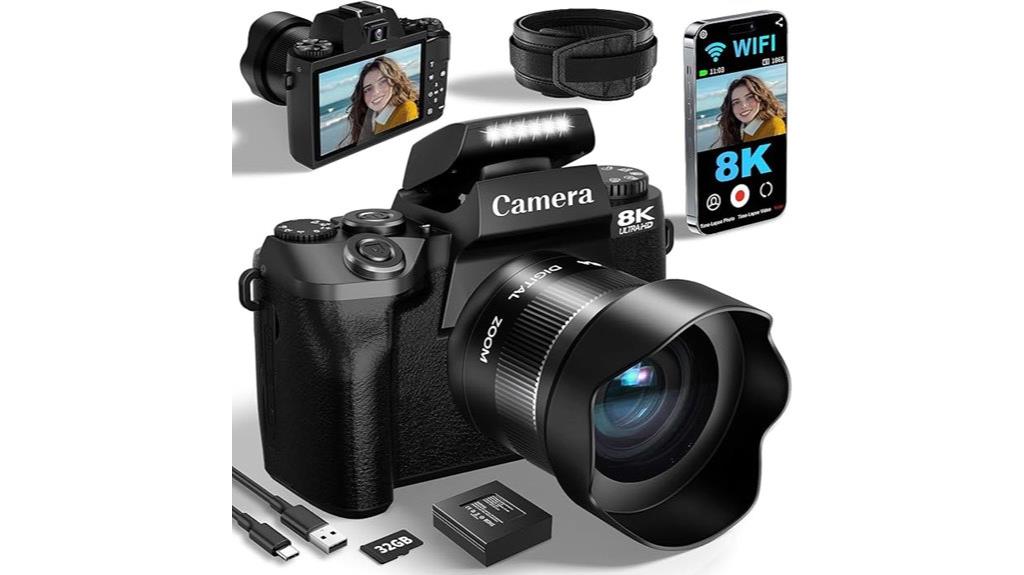
If you’re looking for a versatile camera that excels in both photography and vlogging, this K Digital Camera is a top choice. It offers stunning 8K resolution and 64MP photos with vibrant colors, plus a 16X digital zoom and autofocus for sharp images. Its waterproof design handles depths up to 16 feet, capturing clear underwater photos and videos. The camera features dual screens, a large touchscreen, built-in flash, and easy connectivity via WiFi for instant sharing on social platforms. Lightweight and user-friendly, it’s perfect for travel, content creation, and everyday use, making it an all-in-one tool for both beginners and enthusiasts.
Best For: content creators, vloggers, and photography enthusiasts seeking a versatile, high-resolution camera for both land and underwater photography.
Pros:
- Exceptional 8K resolution and 64MP photos deliver stunning image quality.
- Waterproof design with underwater capabilities up to 16 feet, ideal for underwater photography and videos.
- User-friendly interface with dual screens and built-in WiFi for easy sharing and live streaming.
Cons:
- Slightly heavier weight may reduce portability for some users.
- Advanced features like 8K video may require powerful editing hardware.
- Limited battery life for prolonged shooting sessions without additional power sources.
5K Digital Camera with 64MP, 3” Flip Screen, 16X Zoom, WiFi, Autofocus, 2 Batteries & 32GB TF Card

The K Digital Camera with 64MP, 3-inch flip screen, and 16X zoom stands out as an excellent choice for beginner photographers and vloggers seeking high-quality images and versatile recording options. Its 64MP sensor captures detailed, vibrant photos with rich color and contrast, while supporting 5K video guarantees sharp, stabilized footage. The 16X digital zoom and autofocus deliver crisp shots, even of fast-moving subjects. The flip screen makes framing easy, especially for vlogging, and WiFi allows quick wireless sharing. With two batteries and a 32GB TF card included, you get extended shooting time and ample storage. It’s a user-friendly, all-in-one device perfect for those starting out in photography or content creation.
Best For: beginner photographers and vloggers seeking high-quality images, versatile recording features, and easy sharing options.
Pros:
- High-resolution 64MP sensor captures detailed, vibrant images with rich color and contrast.
- Supports 5K video recording with stabilization, ideal for professional-looking videos.
- Flip screen, autofocus, and 16X zoom make it easy to frame shots and capture moving subjects.
Cons:
- May have a learning curve for complete beginners unfamiliar with advanced camera features.
- Limited to 3-inch flip screen, which might be small for some users to review shots comfortably.
- Additional accessories or upgrades might be needed for more advanced photography needs.
FLATIC 6K 64MP Digital Camera with WiFi & Microphone
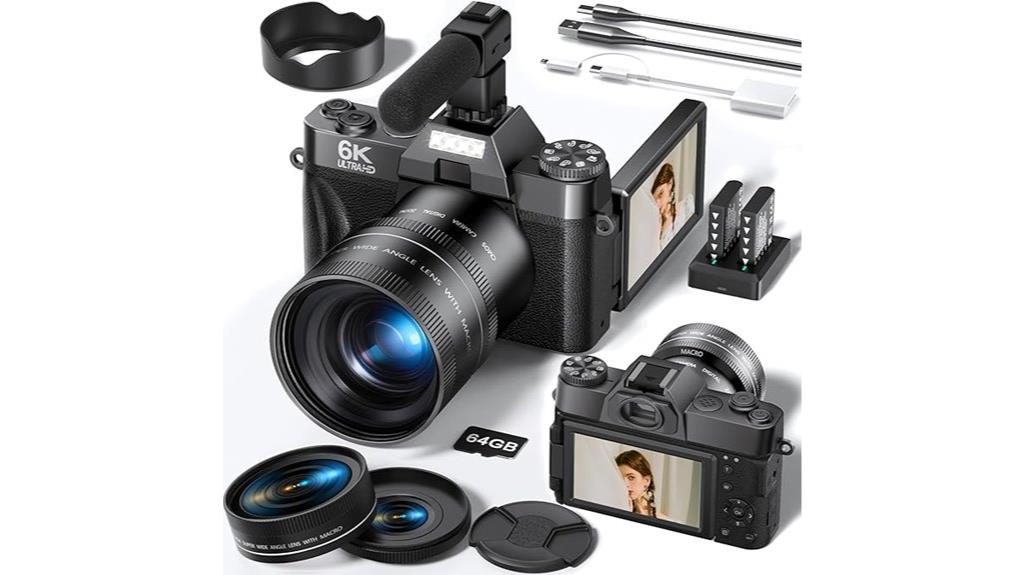
For content creators seeking a versatile camera that combines high-resolution imaging with seamless connectivity, the FLATIC 6K 64MP Digital Camera with WiFi & Microphone stands out. It captures stunning 6K videos and sharp photos, perfect for vlogs, travel, and creative projects. The flip screen makes self-recording easy, while autofocus and 16× zoom help track distant subjects. The included external mic boosts audio quality, and WiFi allows quick wireless sharing. With extensive accessories, a user-friendly interface, and adaptable features like time-lapse and slow motion, this camera offers excellent value for both beginners and seasoned creators.
Best For: content creators, vloggers, and travel enthusiasts seeking high-resolution videos, versatile features, and easy connectivity in a user-friendly camera.
Pros:
- Captures ultra-clear 6K videos and sharp 64MP photos, ideal for professional-quality content.
- Flip screen, external microphone, and extensive accessories enhance vlogging and creative flexibility.
- WiFi connectivity and remote app control facilitate quick sharing and easy operation.
Cons:
- Autofocus performance may have limitations in certain scenarios.
- Moderate zoom range might not suit all distant object capturing needs.
- Some users report occasional inconsistencies in photo quality.
Canon EOS Rebel T7 DSLR Camera with 18-55mm Lens

The Canon EOS Rebel T7 DSLR Camera with 18-55mm lens stands out as an excellent choice for beginners and hobbyists looking to explore high-speed photography. Its 24.1 MP CMOS sensor delivers crisp, vibrant images in various lighting conditions, while the ISO range of 100-6400 (expandable to 12800) boosts low-light performance. Easy to use, with intuitive controls and helpful guides, it’s perfect for learning. Its compact, durable design makes it portable, and built-in Wi-Fi and NFC enable quick sharing. With reliable autofocus, Full HD video, and compatibility with different lenses, this camera offers professional results at an affordable price, making it ideal for new photographers.
Best For: beginners and hobbyists seeking an easy-to-use, portable DSLR camera that delivers high-quality images and versatile shooting options.
Pros:
- 24.1 MP CMOS sensor produces crisp, vibrant images with excellent detail.
- User-friendly controls and real-time Feature Guide facilitate easy learning for newcomers.
- Built-in Wi-Fi, NFC, and Bluetooth enable quick sharing and connectivity options.
Cons:
- Limited to an ISO range up to 6400 (expandable to 12800), which may be less effective in extremely low-light situations.
- The kit lens (18–55mm) may require upgrades for more specialized photography needs.
- No 4K video recording, only Full HD 1080p, which might be a drawback for videographers.
AmScope MD500 5MP USB Microscope Camera
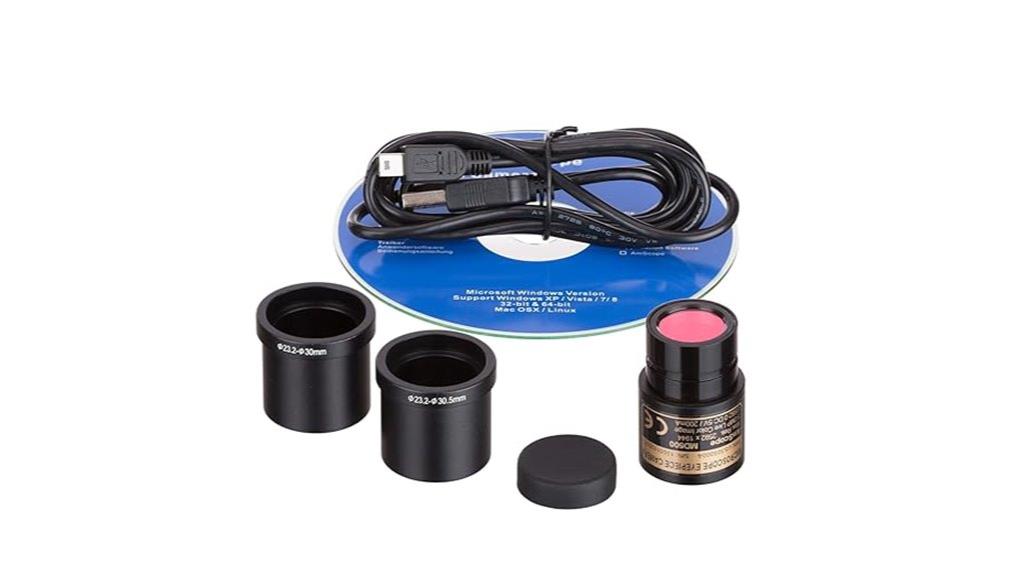
If you’re seeking an affordable and user-friendly digital microscope camera for educational or hobbyist use, the AmScope MD500 5MP USB Microscope Camera is a solid choice. It captures still images, streams live videos, and works with Windows XP through 10. The camera supports multiple mounting sizes with included adapters, making it versatile. While image quality is decent for general observations, it struggles with high magnification focus and detailed clarity. The software offers powerful features like editing and measurement tools, but can be overwhelming for beginners. Overall, it’s a practical, budget-friendly device perfect for casual science projects and educational demonstrations.
Best For: hobbyists, educators, and casual users seeking an affordable, easy-to-use digital microscope camera for basic observation and educational demonstrations.
Pros:
- Compatible with Windows XP through 10 and multiple mounting sizes with included adapters
- User-friendly software with powerful editing, measurement, and stitching features
- Affordable price point makes it accessible for beginners and educational settings
Cons:
- Limited image clarity and difficulty with high magnification focus
- Small field of view (approximately 5mm x 5mm) restricts viewing larger objects in one frame
- Struggles with active samples like pond protozoa due to slow shutter speed and limited optics
4K Digital Camera for Photography with WiFi and 64MP
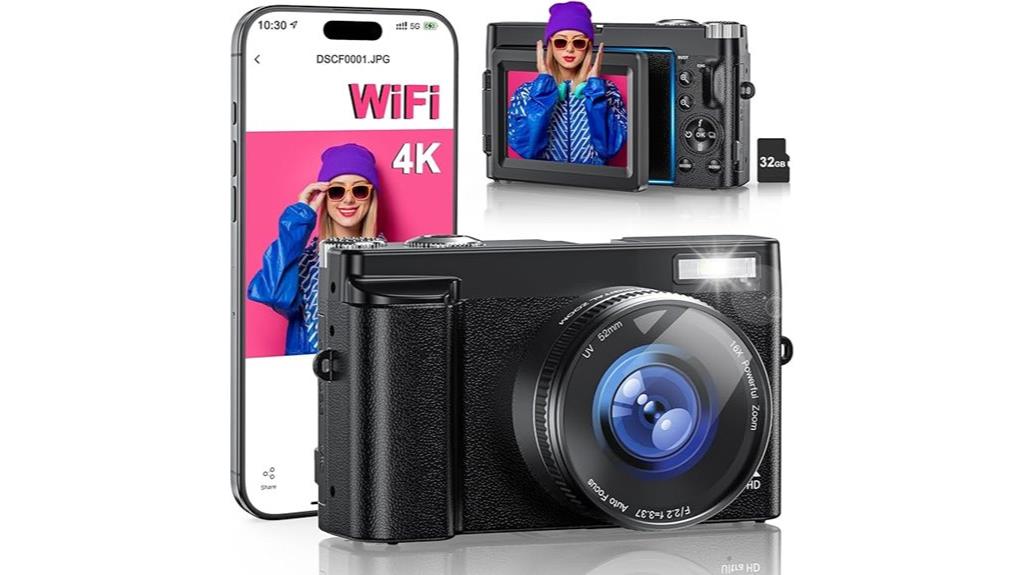
This K Digital Camera with WiFi and 64MP stands out as an excellent choice for casual photographers and content creators who prioritize portability and instant sharing. Its 64MP sensor captures stunning, vibrant images, while 4K video recording ensures ultra-high-definition footage. Features like auto focus, 16X digital zoom, anti-shake, and various creative filters make shooting versatile and easy. The 180° flip screen is perfect for selfies and vlogging. Compact and lightweight, it’s ideal for travel. Built-in WiFi allows quick wireless transfers via the Viipulse app, making it simple to share content instantly or stream live. It’s a reliable, user-friendly option for everyday photography needs.
Best For: casual photographers, content creators, and travelers seeking portable, easy-to-use camera with instant sharing capabilities.
Pros:
- High-resolution 64MP photos and 4K Ultra HD video recording ensure stunning image and video quality.
- Built-in WiFi and compatibility with the Viipulse app allow quick wireless sharing and live streaming.
- 180° flip screen and lightweight design make it perfect for selfies, vlogging, and on-the-go photography.
Cons:
- Limited manual controls compared to professional DSLR cameras.
- Might lack advanced features required for professional photography.
- Battery life may be constrained with extended use, requiring additional batteries.
Factors to Consider When Choosing High‑Speed Cameras for Experiments

When selecting a high-speed camera for experiments, I focus on key factors like frame rate capabilities and lighting needs to guarantee accurate captures. I also consider sensor sensitivity to handle various environments and how well the camera integrates with software for smoother workflows. Finally, resolution and image quality are essential for detailed analysis and reliable results.
Frame Rate Capabilities
Choosing a high-speed camera hinges on understanding its frame rate capabilities, which directly impact how many images it can capture per second. High-speed cameras can range from a few hundred to several thousand FPS, depending on the model. Achieving higher frame rates often requires specialized sensors and fast data transfer interfaces like USB 3.0, SDI, or HDMI to handle the large data volume. Keep in mind, the maximum frame rate is usually specified at certain resolutions; increasing resolution typically reduces FPS. Additionally, lighting conditions, exposure settings, and image resolution influence the actual usable frame rate during experiments. For consistent results, select a camera that can sustain high frame rates over extended periods without overheating or data bottlenecks.
Lighting Requirements Needed
High-speed cameras demand more than just impressive frame rates; they also require proper lighting to produce clear, usable images. Because these cameras often need very short exposure times, high-intensity, uniform lighting—like 500W LED spotlights—is essential. Inadequate lighting results in dark, grainy images or motion blur, especially with fast-moving objects. Proper illumination helps the camera maintain ideal exposure, allowing higher shutter speeds and better image quality during high-speed recording. Bright, flicker-free lighting prevents artifacts and guarantees consistent brightness, which is vital for accurate measurements and analysis. As frame rates increase, the need for specialized lighting setups grows, since more light is required to compensate for reduced exposure times and avoid underexposure. Good lighting is key to capturing sharp, clear high-speed footage.
Sensor Sensitivity Level
Sensor sensitivity, often measured as ISO or gain, is a vital factor because it determines how effectively a camera can capture images in low-light conditions. A high sensitivity allows the camera to record clear, detailed images even with limited illumination, which is essential for high-speed experiments where lighting might be constrained. Additionally, a sensor’s quantum efficiency impacts its ability to convert incoming photons into electrical signals, directly affecting the accuracy of fast event detection. However, increasing sensitivity can introduce noise, so finding the right balance is key to maintaining image quality. The sensor’s dynamic range also plays a role, enabling it to capture both bright and dark details simultaneously. Choosing a sensor with ideal sensitivity ensures precise, high-quality recordings of rapid phenomena.
Compatibility With Software
When selecting a high-speed camera for experiments, it’s important to make certain it works smoothly with your existing software and hardware setup. I check that the camera supports my operating system, whether Windows, Linux, or macOS, for seamless integration. Compatibility with my preferred software—like OpenCV, LabVIEW, or proprietary SDKs—is essential for capturing and analyzing data efficiently. I also verify the camera’s interfaces, such as USB 3.0, USB-C, or HDMI, making sure they’re supported by my imaging tools. Additionally, I look for accessible, well-documented SDKs or APIs, which allow for custom software development or automation. Features like external trigger support, real-time data streaming, and multi-camera synchronization are critical for complex experiments, so I ensure these are compatible as well.
Resolution and Image Quality
Choosing the right resolution and image quality is essential because they directly influence how well you can observe and analyze fast-moving experimental phenomena. Higher resolution sensors, like 64MP or 88MP, capture more detailed images, revealing fine features critical for accurate analysis. Image quality depends on sensor size, pixel density, and the camera’s ability to handle low-light conditions without excessive noise. Global shutter technology is indispensable, as it prevents distortion when capturing rapid motion. However, higher resolutions often mean lower maximum frame rates, so you need to balance detail with real-time data needs. Additionally, image processing quality, color accuracy, and dynamic range greatly impact how useful the footage is for detailed examination. Prioritizing these factors ensures you get clear, precise data from your high-speed camera.
Physical Size and Weight
The physical size and weight of a high-speed camera play a crucial role in how easily it integrates into your experimental setup. Smaller models, around 2 inches long and under 1 pound, are ideal for handheld use or fitting into tight spaces. Larger cameras, over 8 inches and weighing more than 5 pounds, often need sturdy mounts or rigs, but they may offer enhanced stability and features. The size impacts compatibility with existing equipment like microscopes or tripods, so choosing a camera that matches your environment is essential. Lighter cameras are easier to handle and reposition, while heavier ones provide stability during long recordings. Carefully consider your setup’s space constraints and mounting requirements to ensure your high-speed camera fits seamlessly into your experiment.
Triggering and Control Options
Selecting a high-speed camera that integrates seamlessly with your experimental setup involves considering its triggering and control options. External trigger inputs, like hardware triggers, let you synchronize recording precisely with external events or sensors. Many models also support software-based triggering, which allows you to control recording through dedicated applications, ensuring exact start and stop times. Triggering capabilities often include flash synchronization, enabling the camera to fire in sync with external flashes or lighting systems for ideal image capture. Programmable trigger modes, such as continuous, single, or multi-shot, provide flexibility for different experiments. Control interfaces vary from physical ports like BNC or GPIO to wireless options like Wi-Fi or Bluetooth, offering versatile and convenient integration for your laboratory setup.
Cost and Budget Constraints
When working within a specific budget, it’s important to match a high-speed camera’s features to your financial limits. Cameras can range from a few hundred to tens of thousands of dollars, so understanding what you need is key. Higher frame rates, better resolution, and advanced features like external triggers substantially increase costs. Budget constraints might mean choosing entry-level models that offer lower frame rates or reduced resolution, which can affect experiment accuracy. Don’t forget to contemplate additional expenses for accessories, storage, and software compatibility. To make the most of your budget, focus on essential features that meet your experiment’s core requirements. Prioritizing these helps ensure you get a cost-effective camera that delivers reliable performance without overspending.
Frequently Asked Questions
How Do High-Speed Cameras Differ in Frame Rate Versus Resolution?
High-speed cameras differ mainly in frame rate and resolution. Frame rate measures how many frames they capture per second; higher rates show faster events in detail. Resolution, on the other hand, indicates the clarity and detail of each frame. I’ve found that increasing one often means compromising the other, so I choose based on whether I need ultra-slow motion or sharp, detailed images.
What Are the Ideal Lighting Conditions for Ultra-Fast Video Capture?
Think of capturing ultra-fast moments like catching a shooting star; you need the right conditions. Bright, consistent lighting is essential, preferably high-intensity LED or strobe lights, to freeze motion without blur. I once filmed a water droplet experiment in dim light, and the detail was lost. Proper lighting guarantees your camera’s sensor can keep up, revealing every rapid movement in crisp, clear detail.
How Does Storage Capacity Impact Long-Duration High-Speed Recordings?
Storage capacity is essential for long-duration high-speed recordings because it directly affects how much footage I can capture without interruptions. When I record at ultra-fast frame rates, files become large quickly, so having ample storage guarantees I don’t run out of space mid-experiment. I always opt for high-capacity, fast drives to handle the data flow smoothly, preventing loss of important moments and maintaining quality.
Are There Specific Accessories Needed for Specialized High-Speed Experiments?
Yes, I always recommend accessories tailored to your specific experiment. For example, you might need high-capacity storage devices for long recordings, specialized lenses for capturing fine details, or external lighting to illuminate fast-moving subjects. Sometimes, remote triggers or vibration isolators improve stability and timing. Assess your experiment’s unique requirements, then choose accessories that enhance camera performance and guarantee you get accurate, high-quality results every time.
What Maintenance Tips Ensure Optimal Performance of High-Speed Cameras?
To keep your high-speed camera performing at its best, I recommend regularly cleaning the lens and sensor with a soft, lint-free cloth—imagine gentle whispers of dust being swept away. Keep the camera dry and protected from extreme temperatures, like a shield in a storm. Also, update firmware when available, like giving your camera a revitalizing boost. Routine checks and proper storage ensure your gear stays sharp and reliable for every ultra-fast shot.
Conclusion
Ultimately, selecting the right high-speed camera hinges on your specific needs and nuances. By balancing budget, bandwidth, and brilliance, you can capture crisp, clear, and engaging clips that elevate your experiments. Remember, the perfect device delivers dynamic details without draining your dime or delaying your deadlines. Immerse yourself in the diverse options, determine your demands, and discover a device that deftly delivers dazzling, detailed data—making your moments memorable and measurable.
